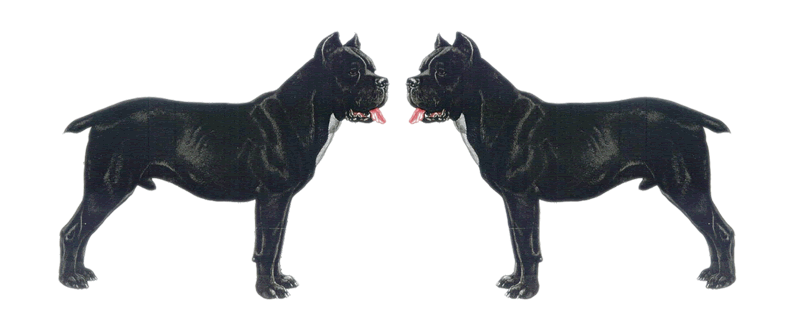ANKC & FCI Cane Corso Standard
ANKC STANDARD
Group: | The term Cane Corso has been used for many centuries in Italy. Pronounced Carn-ay Corso (Cane being Italian for 'dog' and Corso derived from the Latin Cohors meaning protector), the breed's name literally means 'guardian' or 'protector dog'. Historically, this term perhaps initially described a type of dog rather than a specific breed. The Cane Corso is of mastiff origins and was most commonly used to protect property, livestock and family; as a dog of war; to herd stock and hunt game and also possibly for entertainment - fighting lions and bears in the colosseums. |
History: | The Cane Corso type became less popular in Italy preceding the 1950s and a subsequent recovery process was put in place by Italian enthusiasts. The type was formally recognised in Italy in 1987 and an approved standard was written. In 1996 the breed was recognised on an international level. In 2003 the breed was formally recognised by the Australian National Kennel Council (ANKC). There are presently only about 20 in Australia. |
General Appearance: | A medium to large sized dog. Robust and sturdy but nevertheless elegant. Lean with powerful muscles. He is now used as a guard, protection, police or tracking dog. Important proportions: The length of the head reaches 36% of the height at the withers. The dog is somewhat longer than high. |
Characteristics: | (Not specified.) |
Temperament: | He is a guardian of property, family and livestock and is extremely agile and responsive. In the past it has been used for herding cattle and hunting big game. |
Head And Skull: | The head is large and typically molossoid. The upper longitudinal axis of the skull and the muzzle converge slightly. Skull: Wide. At the zygomatic arches its width is equal to or greater than its length. Convex in front, it becomes fairly flat behind the forehead as far as the occiput. The medio-frontal furrow is visible. Stop: Marked Nose: Black and large with ample, open nostrils, on the same line as the nasal bridge. Muzzle: Noticeably shorter than the skull (ratio muzzle to skull approximately 1 to 2). Strong and square, the front part of the muzzle is flat. The lateral surfaces are parallel. The muzzle is as wide as it is long. The profile of the nasal bridge is straight. Lips: The upper lips hang moderately and cover the mandible, so that the lower profile of the muzzle is determined by the lips. Jaws: The jaws are very large, thick and curved. |
Eyes: | Dark and round, low down in skull and set far apart. Light or pink eyes undesirable. No pink eyelids. |
| Ears: | Triangular and drooping, wide, set on high above the zygomatic arches. |
| Mouth: | Slightly undershot. A level bite is acceptable but not sought after. |
| Neck: | Strong and muscular. As long as the head. |
| Forequarters: | Shoulders: Long, oblique and very muscular; Upper arm: Strong; Forearm: Straight and very strong; Carpal joint and pasterns: Elastic. |
| Body: | The body is somewhat longer than the height at the withers. The Corso is sturdily built but not squat. |
| Hindquarters: | Upper thigh: Long, wide, back line of thigh convex; Lower thigh: Strong, not fleshy; Hocks: Moderately angulated; Metatarsals: Thick and sinewy. |
| Feet: | The forefeet are cat feet and the hind feet are slightly less compact. |
| Tail: | Set on fairly high and very thick at the root. The tail is docked at the fourth vertebra. In action carried high, but never curled nor erect. |
| Gait/Movement: | Long stride with extended trot. The preferred gait is the trot. |
| Coat: | Short, shiny and very dense with a light undercoat. |
| Colour: | Black, lead-grey, slate grey, light grey, light fawn, stag red and dark fawn, brindle (stripes of different shades of fawn or grey). In fawn coloured and brindle dogs the black or grey mask on the muzzle should not go beyond the line of the eyes. A small white patch on the chest, on the tips of the feet and on the bridge of the nose is acceptable. |
| Sizes: | Height at withers: Males from 64 to 68 cm |
| Faults: | Any departure from the foregoing points should be considered a fault and the seriousness with which the fault should be regarded should be in the exact proportion to its degree. |
| Notes: | Male animals should have two apparently normal testicles fully descended into the scrotum. |
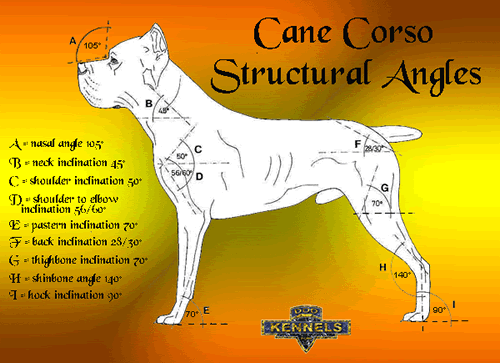
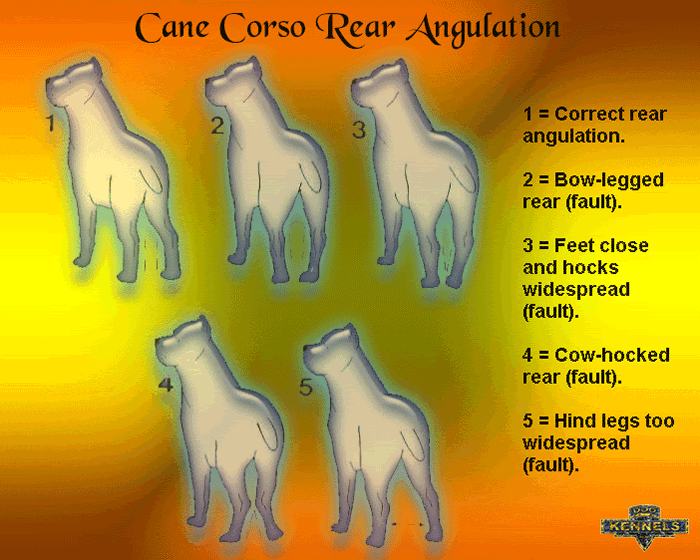
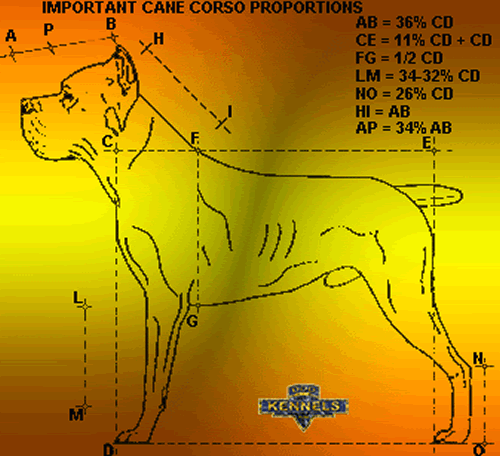
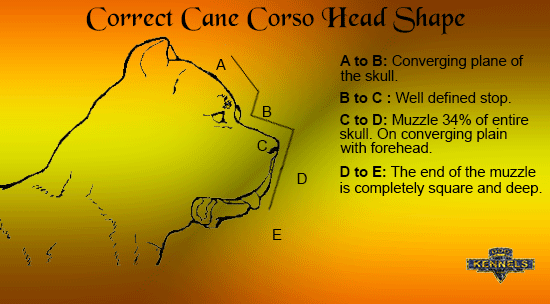
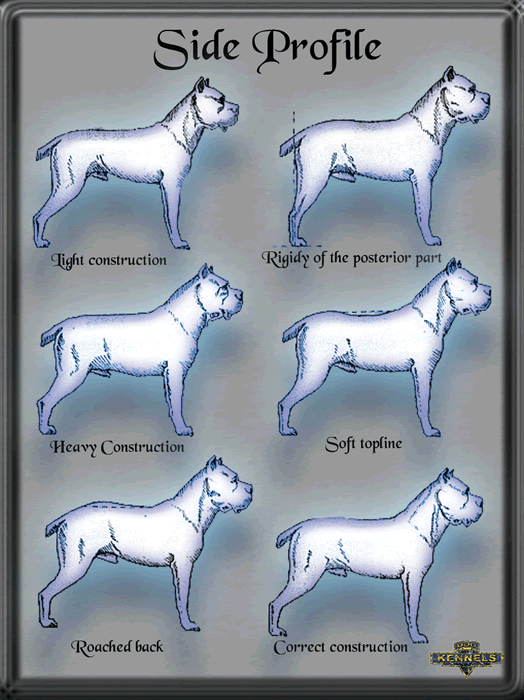
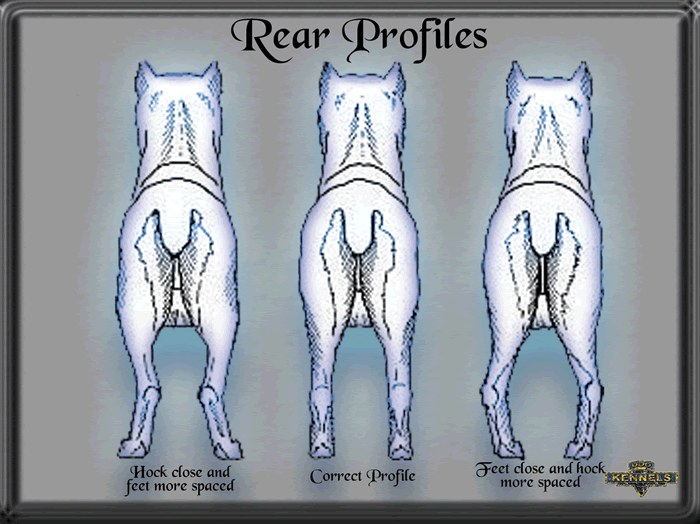
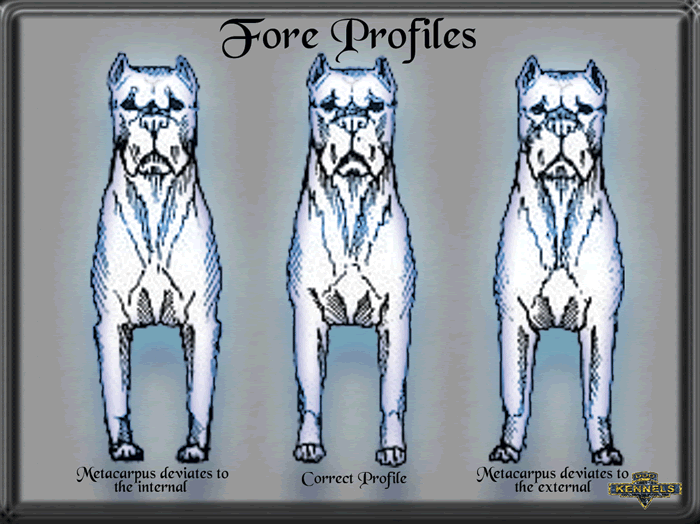

FCI - Standard Number 343 / 12.03.1999 / GB
ITALIAN CORSO DOG
(Cane Corso Italiano)
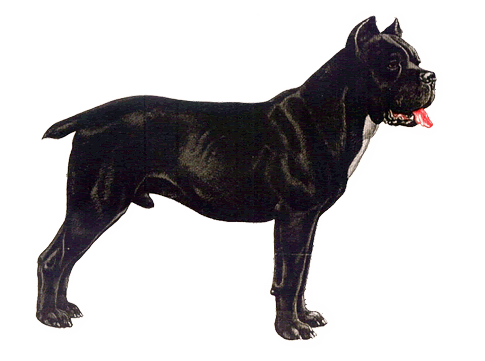
TRANSLATION : Dr. Antonio Morsiani, Dr. J.-M. Paschoud and Prof. R. Triquet.
ORIGIN : Italy.
DATE OF PUBLICATION OF THE ORIGINAL VALID STANDARD : 12.03.1999.
UTILIZATION : Guard- protection- police-and tracking dog.
CLASSIFICATION F.C.l. : Group 2 Pinscher and Schnauzer, Molossian and Swiss
Mountain- and Cattledogs.
Section 2.1 Molossian, Mastiff type.
Without working trial.
BRIEF HISTORICAL SUMMARY : Its direct ancestor is the old Roman Molossian. Formerly scattered all over ltaly, in the recent past, the breed was only prevalent in the Province Apulia and in the adjacent regions of Southern Italy. His name derives from the Latin << cohors », which means << protector, guardian of the farmyard >>.
GENERAL APPEARANCE : Medium to large-sized. Robust and sturdy, nevertheless elegant. Lean, powerful muscles.
IMPORTANT PROPORTIONS : The length of the head reaches 36 % of the height at withers. The dog is somewhat longer than high.
BEHAVIOUR / TEMPERAMENT : Guardian of property, family and livestock; extremely agile and responsive. ln the past, it has been used for herding cattle and hunting big game.
HEAD : Large and typically molossoid. The upper longitudinal axes of the skull and the muzzle converge slightly.
CRANIAL REGION :
Skull : Wide at the zygoinatic arches its witdh is equal to or greater than its length. Convex in front, it becomes fairly flat behind the forehead as far as the occiput. The medio-frontal furrow is visible.
STOP: Marked.
FACIAL REGION :
Nose : Black and large with ample, open nostrils, on the same line as the nasal bridge.
Muzzle : Noticeably shorter than the skull (ratio muzzle : skull approximately I : 2). Strong, square; the front part of the muzzle is flat; the lateral surfaces are parallel; the muzzle is as wide as long. The profile of the nasal bridge is straight.
Lips : The upper lips hang moderately and cover the mandible, so that the lower profile of the muzzle is determined by the lips.
Jaws/Teeth : Jaws very large, thick and curved. Slightly undershot. Level bite acceptable, but not sought after.
Eyes : Medium-sized, ovoid, looking directly forward, slightly protruding. Eyelids close fining. Colour of iris as dark as possible, depending from the colour of the coat. Expression keen and attentive.
Ears: Triangular, drooping, with a wide set on high above the zygomatic arches. Often cropped in the shape of an equilateral triangle.
NECK : Strong, muscular, as long as the head.
BODY : The body is somewhat longer than the height at the withers. Sturdily built, but not squat.
Withers : Pronounced, rising above the level of the croup.
Back : Rectilinear, very muscular and firm.
Loins : Short and strong.
Croup : Long, wide, slightly inclined.
Chest : Well developed in three dimensions, reaches to the elbow.
TAIL : Set on fairly high; very thick at the root. The tail is docked at the fourth vertebra. In action carried high, but never curled nor erect.
LIMBS
FOREQUARTERS :
Shoulders : Long, oblique, very muscular.
Upper arm : Strong.
Forearm : Straight, very strong.
Carpal joint and pasterns : Elastic.
Forefeet : Cat feet.
HINDQ QUARTERS :
Upper thigh : Long, wide, back line of thigh convex.
Lower thigh : Strong, not fleshy.
Hocks : Moderately angulated.
Metatarsals : Thick and sinewy.
Hindfeet : Slightly less compact than the forefeet.
GAIT I MOVEMENT : Long stride, extended trot. The preferred gait is the trot.
SKIN : Fairly thick, rather close ?tting.
COAT
HAIR : Short, shiny, very dense with a light undercoat.
COLOUR : Black, lead-grey, slate-grey, light grey, light fawn; stag red and dark fawn; brindle (stripes on different shades of fawn or grey); in fawn coloured and brindle dogs the black or grey mask on the muzzle should not go beyond the line of the eyes. A small white patch on the chest, on the tips of the feet and on the bridge of the nose is acceptable.
SIZE AND WEIGHT :
Height at withers : Males from 64 to 68 cm,
Females from 60 to 64 cm.
Tolerance of 2 cm more or less.
Weight : Males from 45 to 50 kg,
Females from 40 to 45 kg.
FAULTS : Any departure from the foregoing points should be considered a fault and the seriousness with which the fault should be regarded should be in exact proportion to its degree.
SEVERE FAULTS :
. Axes of muzzle and skull parallel or too converging; lateral surfaces of the muzzle converging.
. Partial depigmentation ofthe nose.
. Scissor bite; pronounced undershot mouth.
. Ring-tail, tail in vertical position.
. Permanent amble when trotting.
. Over-or undersize.
ELIMINATING FAULTS :
. Axes of muzzle and skull diverging.
. Total depigmentation of the nose.
. Bridge of nose very hollow, rams’s nose.
. Overshot mouth.
. Partial or complete palpebral depigmentation. Wall eye; strabism.
. Tailless, short tail (docked or not).
. Semi-long, smooth or fringed hair.
. All colours not indicated in the standard; large white patches.
N.B. : Male animals should have two apparently normal testicles fully
descended into the scrotum.
